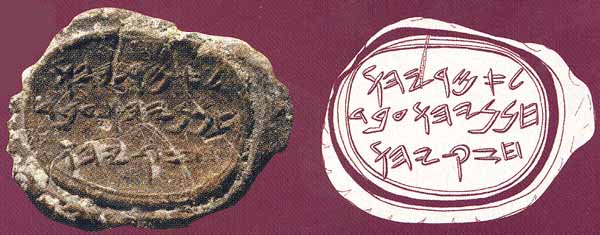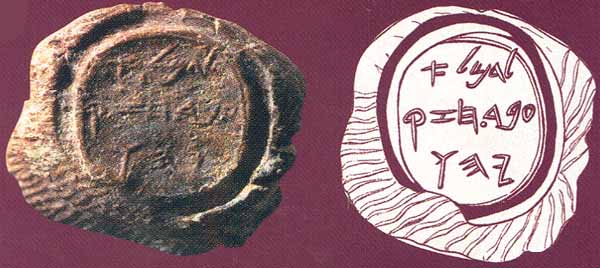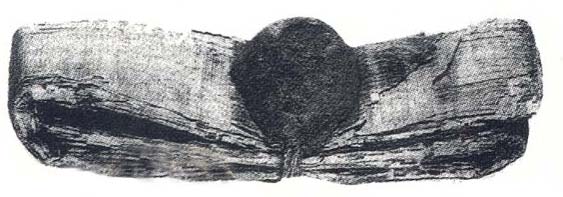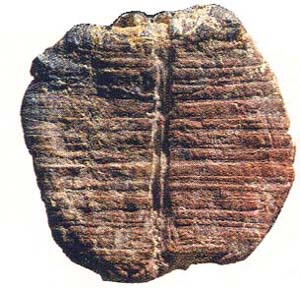Newly Unveiled Seal Impression Attests Another Biblical Figure
Sidebar to: Lasting Impressions048

It’s a rare thrill when an ancient artifact turns up bearing the name of a person mentioned in the Bible. In the newly revealed group of bullae, four are imprinted with the seals of high officials in Hezekiah’s court. Three bear the inscription “servant of Hezekiah,” a term that does not denote a particular office but indicates that the seal’s owner is an elite member of the king’s court.1 Of these three, one bulla now allows us to add a name to the short (but growing) list of archaeologically attested Biblical figures.2
The Book of Chronicles (2 Chronicles 31) tells what happened after the pillars, sacred posts, shrines and altars outside Jerusalem had been smashed and destroyed as part of Hezekiah’s religious reforms: The people from the countryside brought large quantities of “grain, wine, oil, honey and all kinds of agricultural produce” (2 Chronicles 31:5) to the Temple in Jerusalem, along with tithes of cattle and sheep. So much was brought that special storehouses were established in the city. The keeper of the East Gate, Kore, was placed in charge of these freewill offerings, with several men under him “in offices of trust.” One of these men was named Amariah, or in Hebrew, Amaryahu (2 Chronicles 31:15).
Bulla A (top) bears the seal of “Amaryahu [son of] Hananyahu.”3 Here is the inscription:
whyqzJ db[ whynnJ whyrmal
l’mryhw / hnnyhw ‘bd / h zqyhw
“Belonging to Amaryahu, [son of] Hananyahu, servant of Hezekiah”
Although Amaryahu is not an uncommon name, it is very probable that this Amaryahu is the man mentioned in the Bible. The bulla specifically identifies Amaryahu as a “servant of Hezekiah,” and the Biblical Amaryahu is clearly a high officer in Hezekiah’s court. It is highly unlikely that more than one person with this name would hold senior positions in the royal service at the same time.
Incidentally, it is interesting that Chronicles, which most scholars recognize as a late book that was composed after the Babylonian Exile, contains such detailed and, in this case, accurate information. Obviously the author was working from older records, a fact that should not be forgotten when assessing the reliability of the Biblical record. Just because the text is late does not mean that it is unreliable.


Two other bullae (bullae B and C, above) bear the name of another “servant of Hezekiah”.4 Here again is an example of one person having more than one copy of his 049seal. The official’s name is Domla; his father is unnamed. Domla is a shortened form of a name with a theophoric (divine) ending, either ‘el or yahu, which would make the complete name either Domla’el or Domlayahu.
Domla means to be patient or silent; the full name would mean “Be silent before the Lord” or “Be patient before Yahweh.” The word appears in Psalm 37:7: “Be patient and wait for the Lord.” The inscription on the bullae reads:
whyqzJ db[ almdl
ldml’ ‘bd hzqyhw
“Belonging to Domla, servant of Hezekiah”

The fourth bulla (above) is impressed with the seal of one Tobshalem, who is identified as the “commander of the army.”5 The inscription reads:
abxh rc µlvbfl
ltbsÆ lm / s r hsb‘
“Belonging to Tobshalem, commander of the army”
This is actually the second time a bulla impressed with this seal has come to light—I published the first one, from the Moussaieff collection, in 1997. Because only part of the first letter of the last word of the inscription was preserved on that first bulla—and the rest of the word was missing—I at the time identified Tobshalem’s title as “governor of the city.” But I was wrong! The missing letters that have come to light on the newly revealed copy of the bulla make it clear that Tobshalem’s position was “commander of the army.”6
Although the seals of Amariah and Domla each contain only an unadorned inscription, an elaborate Egyptian lotus bud appears between the two lines of the inscription on Tobshalem’s seal—another indication of Egypt’s extensive artistic influence in Hezekiah’s time.
The backs of all these bullae, including the bullae of King Hezekiah discussed in the main article, bear the impression of the papyrus documents that the bullae once sealed. Often we even see the imprint of the string that tied the document—a mere groove in the clay. This reminds us that however much these bullae and the seals they preserve fascinate us today, they were originally only fasteners for far more interesting and complete messages borne within documents that have long since disintegrated. We can only guess at the import of those ancient messages. The bullae are all we have left.


